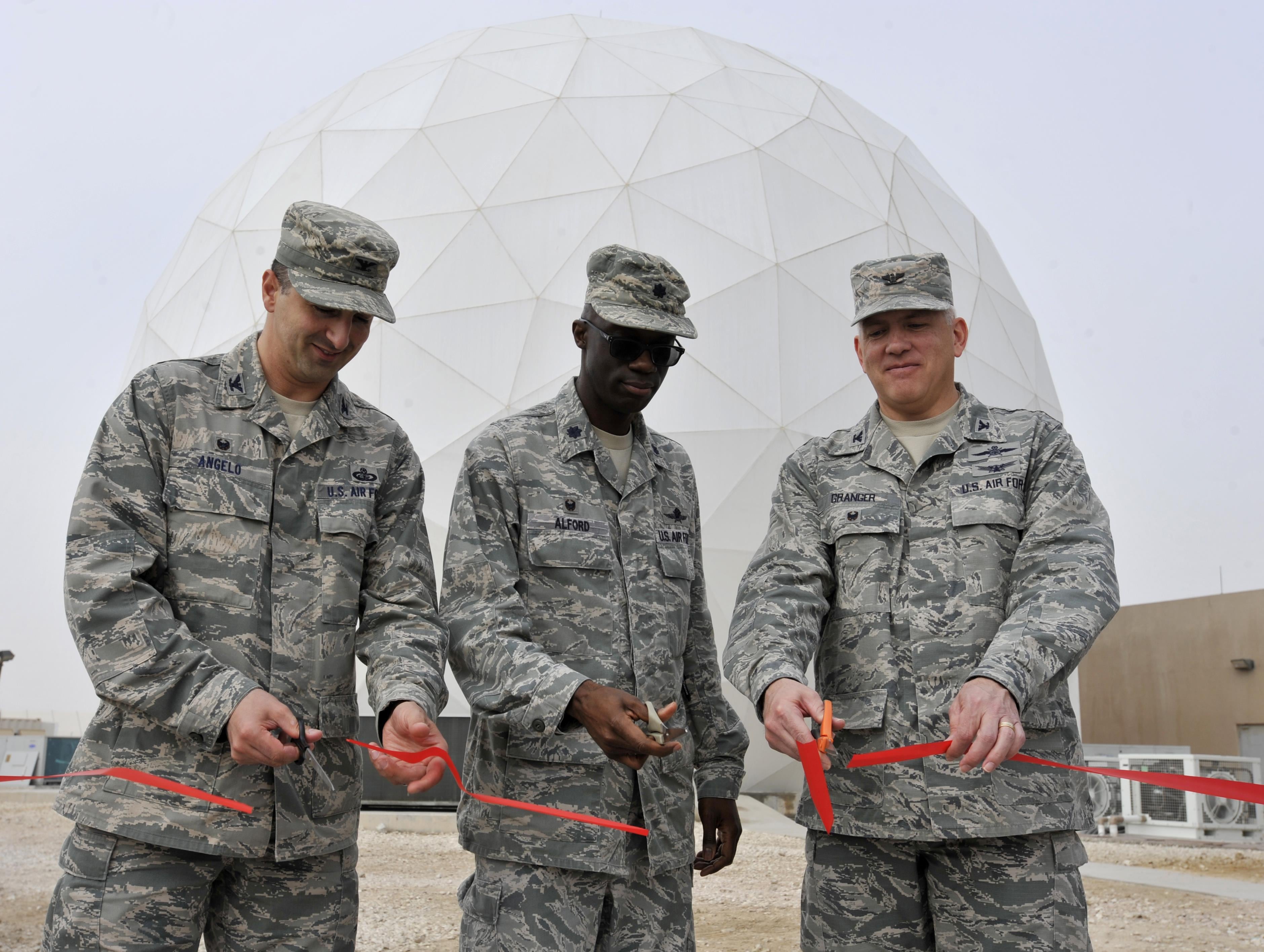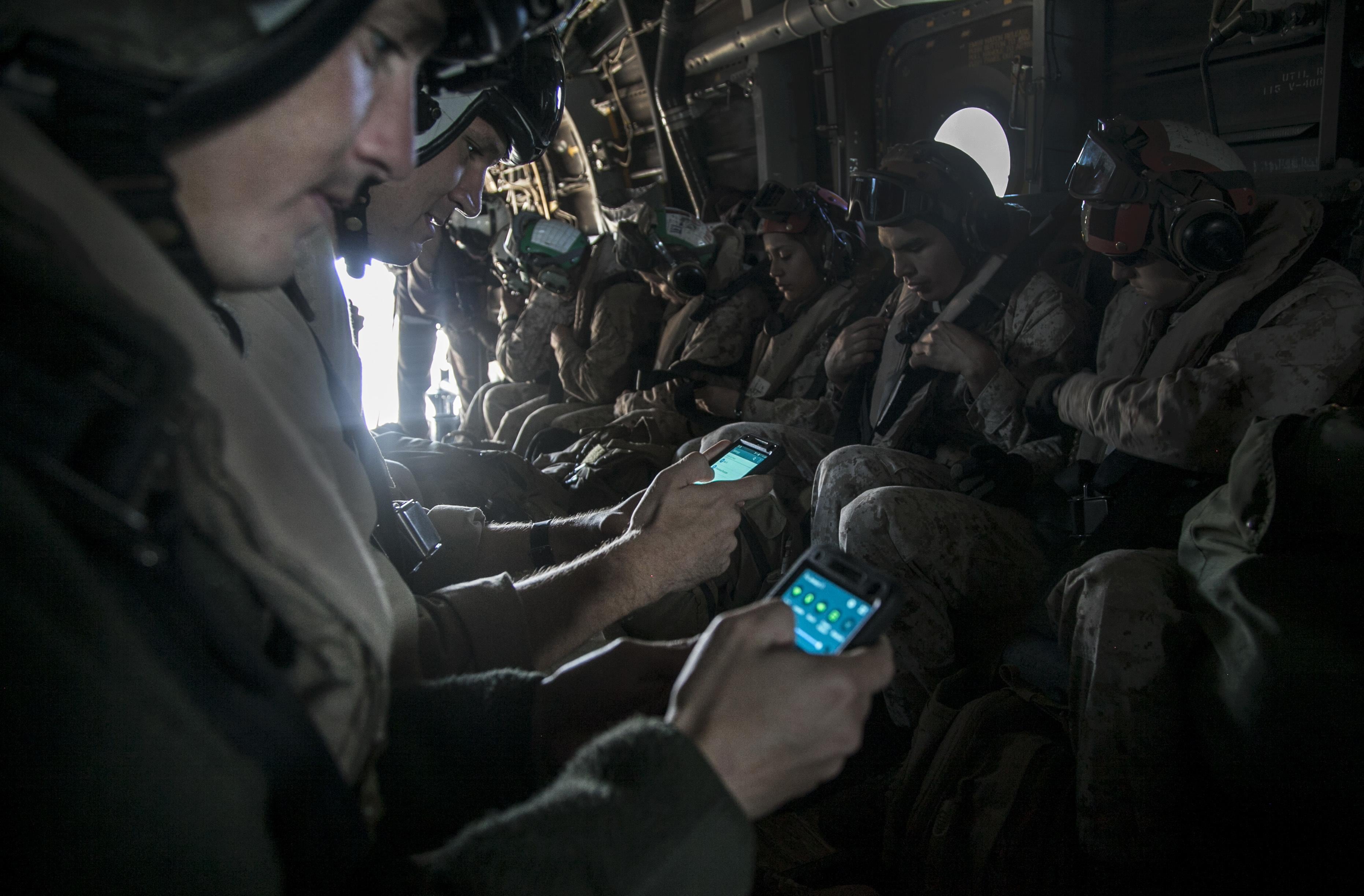When expeditionary communications forces hit the ground, they become the eyes and ears of an operation that map the terrain and gather critical situational awareness. But that data is only good if it can be relayed back to command.
Expeditionary comms have been evolving quickly, with new technologies enabling faster deployment, more stable transmissions and easier transport of vital gear. Improvements include miniaturized radios, easily deployable satellites and simple tablet adaptations.
Terminal upgrades
For the Air Force, the latest news comes in the form of a program known as the modernized enterprise terminal (MET) upgrade. As announced in January, the first $15 million MET outside the United States is now operational: the antenna sits in a radome on the ground at Al Udeid Air Base, Qatar.

Col. Thomas Angelo, 379th Expeditionary Mission Support Group commander, Lt. Col. Carlos Alford, 379th Expeditionary Communications Squadron commander, and Col. Jeffrey Granger, United States Air Forces Central Command Forward Director of Cyber Forces, cut a ribbon signifying completion of the Modernized Enterprise Terminal at Al Udeid Air Base, Qatar, Jan. 21, 2016.
Photo Credit: Master Sgt. Joshua Strang/Air Force
The terminal delivers secure voice, video and data services, along with anti-jamming software. It is part of a larger Department of Defense MET program, which aims to upgrade terminals worldwide as a means to access X- and Ka-band signals using the wideband global communication satellites.
Air Forces Central Command described the improved communications as "vital" for expeditionary forces trying to establish information links for logisticians coming in behind initial entrants. The service expects to install a second MET is at Al Udeid Air Base in 2018.
Radio reductions
Another effort is focusing in on the portability of radios at the forward edge. A workhorse in expeditionary comms, Link 16 radios typically weigh up to 80 pounds, making them impractical for an expeditionary foot soldier. That may be changing, as a 2.4-pound version goes through testing in the spring with an eye toward a December 2016 deployment, said Michael Henry, technical director, Joint Tactical Integration, Joint Staff J6.
The Link 16 radio had proven itself an effective tool in military tactical data exchange. As the standard data link for U.S. and NATO troops, it has enabled fighting forces to share tactical images in near-real time, along with text messages, images and digital voice.
The advent of a handheld model will reduce the kill chain timeline and enhance overall mission success, Henry predicted. "You are going to mitigate fratricide and collateral damage," he said.
The miniaturization of the Link 16 radio speaks to the general dictum that, when it comes to expeditionary comms, smaller is better. Anything that can be carried, or at least driven in on initial entry, ought to make it that much easier to establish communications during the critical early moments and days of an engagement.
Satellites, scaled down
With this in mind, Army's 25th Infantry Division has been looking for a better way, and leaders believe they have found it in a rapidly deployable satellite configuration called Transportable Tactical Command Communications (T2C2), developed by the Program Executive Office Command Control Communications-Tactical in Aberdeen, Maryland.
"It allows us to take something that can be deployed and move it by commercial air. A kid can just take a couple of extra suitcases with him and when they get to the destination they can deploy the satellite," LTC Joe Pishock, 25th infantry division communications officer. The smaller version of T2C2 is the size of two pieces of roll-on luggage and can be deployed in less than 10 minutes.

25th Infantry Division soldiers in Thailand set up an inflatable antenna to provide expeditionary communications.
Photo Credit: CW3 Jinez Font/Army
The readily deployable satellites connect expeditionary forces rapidly to WIN-T, allowing operational situational awareness and command capabilities. Planners say the system should up to 16 times faster than current solutions.
The T2C2 program earned Milestone C designation in on November 2015, at which time it was approved for low-rate initial production and further product verification testing.
"This is the gap filler to give you expeditionary communications while you build up, while you wait for a boat to arrive 30 days later with WIN-T Increment 1," Pishock said.
Network to go
Managed by Marine Corps Systems Command, the Networking-On-The-Move (NOTM) program fields a combat vehicle-based system that includes on-the-move satellite communications systems, tactical radios and network management equipment, secure wireless local area network (LAN) along with ruggedized laptops loaded with tactical software applications.
Through a NOTM unit, "anything you could do in a static large command center, you can now do one a smaller scale while on the move," said Basil Moncrief, team lead for technology transition, Marine Air Ground Task Force-Command and Control Systems.
At 800 lbs., NOTM is compact enough to fit on a Humvee, with secure wireless LAN to connect back to staff vehicles, giving commanders insight up to the edge of the battlefield. This makes the full range of digital command and control communications "highly transportable, highly expeditionary," Moncrief said.

Marines with the 15th Marine Expeditionary Unit test out their tablets aboard a MV-22B Osprey, during Certification Exercise off the coast of San Diego. The Osprey has been fitted with a system of systems that provides small unit leaders with increased situational awareness and enhanced command and control capabilities at extended ranges.
Photo Credit: Cpl. Elize McKelvey/Marine Corps
First fielded in 2014, NOTM is now deployed on three Marine Corps vehicle platforms: the Amphibious Assault Vehicle, HMMWV and Mine-Resistant Ambush Protected All-Terrain Vehicle. So far 56 units have been fielded, half of them built by government at SPAWAR Systems Center Atlantic and half by Pelatron, Inc. at a cost of $140 million for design, testing, building and two years of sustainment.
The Marine Corps also are augmenting expeditionary comms with the creative use of more prosaic tools. In particular, they're using Samsung tablets to achieve extended access to information and communications while in flight. Since deploying an initial six units in the fall, members of the 15th Marine Expeditionary Unit have been sending text, photo, audio and video messages on tablets, said Maj Chuck Buckley, the MEU's communications officer.
It required only a simply modification to install the tablet suite, known as a digital interoperability package, on two CH-53 Super Stallions and four Ospreys. In addition to diverse communications capabilities, the system also allows access to a range of applications including a chat app, an RFID app to track cargo and personnel, mapping tools and dynamic map to guide Marines ashore.
In early testing Marines launched from the amphibious assault ship Essex for a two-hour flight from California to Arizona. The mock rescue mission demonstrated the ability of the digital interoperability package to effectively transmit data via both terrestrial and satellite links. Buckley declared strong acceptance of the tablet suite. "Once people see what the tablet can do and how the architecture works, they are extremely impressed with the range of capabilities it provides," he said.







